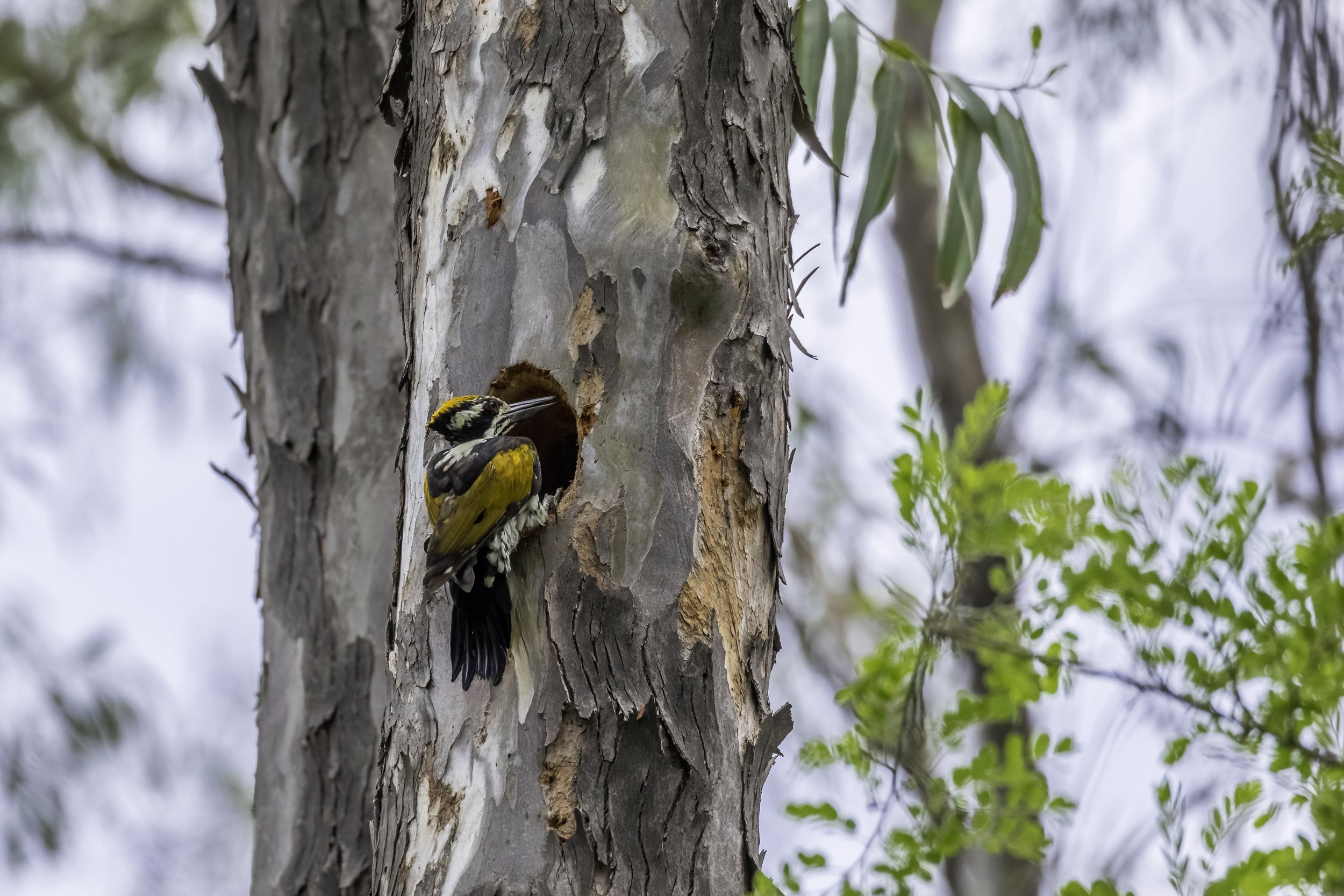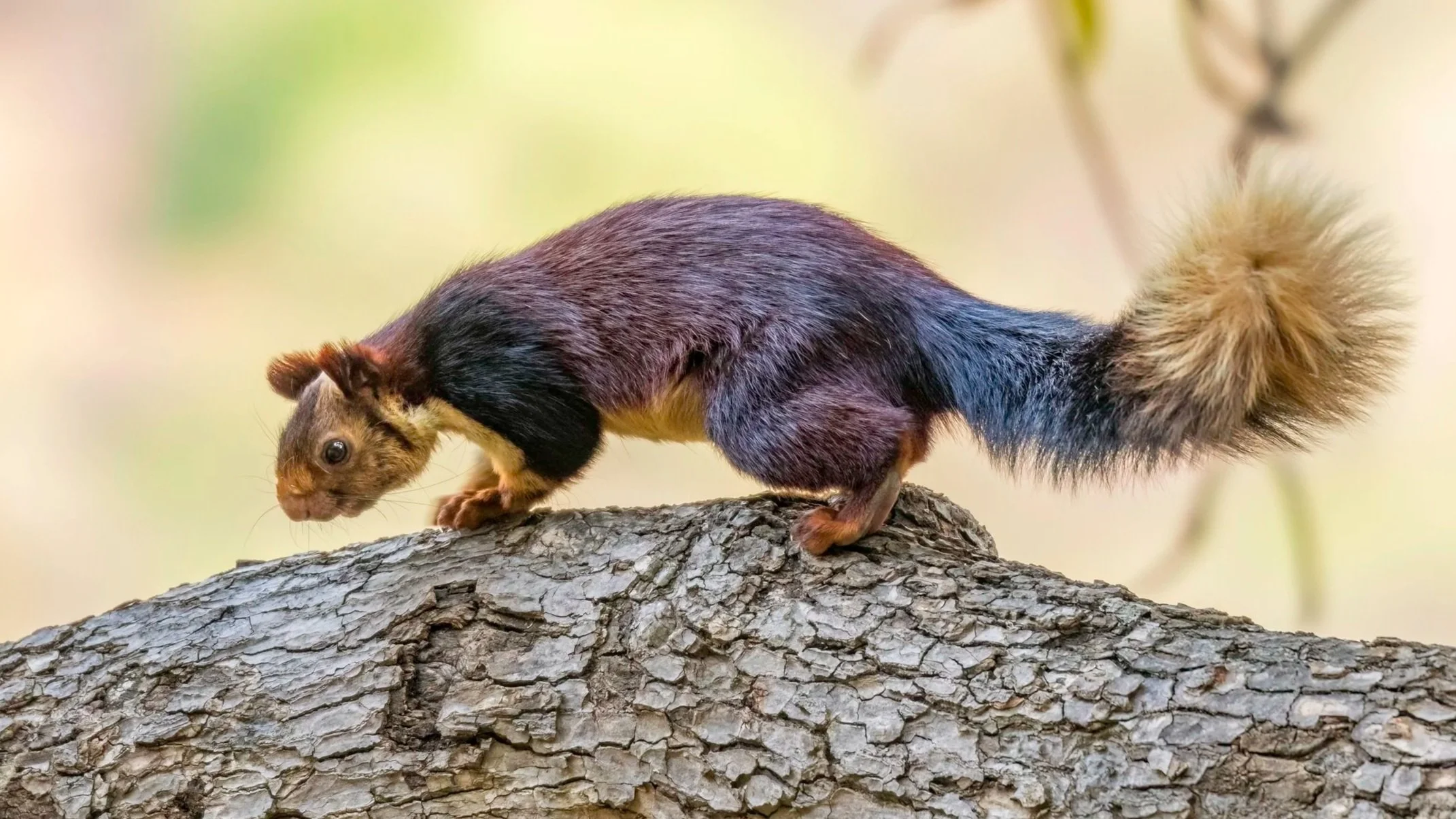White-naped Woodpecker/ Black-shouldered Woodpecker
Chrysocolaptes festivus
Ananthagiri Forest Range, Vikarabad
This week too I continue to explore deep within the Ananthagiri Forest Range and this time I am tracking the endemic and very difficult to spot White-naped Woodpecker also called the Black-shouldered Woodpecker. This is an uncommon, four-toed, large-billed, golden-backed woodpecker endemic to the Indian Subcontinent. It is associated with open wooded habitats all over its range, but is often difficult to find. It is separated from the group of “small-billed” flamebacks by its much larger bill, a conspicuous white nape with a contrasting black border, and a divided black horizontal stripe below the cheek. Separated from the similarly large-billed Greater Flameback by its black rump, clean white nape, and preference for drier habitat. I have often been able to detect it by its uniform trill.
Now on to the where I saw this uncommon woodpecker - the forests of Telangana. Located in the central stretch of the Deccan Plateau, Telangana has sub-tropical climate and the terrain consists mostly of hills, mountain ranges, and thick dense forests covering an area of 27,292 km² (10,538 sq mi). The annual rainfall ranges between 1,100 mm to 1,200 mm and the annual temperature varies from 15 C to 45 C. The State is drained by a number of rivers which include Godavari and Krishna.
Telangana is endowed with rich diversity of flora and fauna. It has dense teak forests on the northern part along the banks of river Godavari. As per the Champion & Seth Classification of Forest Types (1968), the forests in Telangana belong to three Forest Type groups, which are further divided into 12 Forest Types. The State Government has taken up a massive greening programme, 'Telangana Ku Harita Haram' in the State to plant and protect 230 crore seedlings over a period of 4 years. This initiative aims at achieving the twin objectives of increasing the forest cover and reduce pressure on the existing forest resources, through massive community participation by Vana Samrakshna Samithis (VSS) and Eco-Development Committees (EDCs) in Protected Areas and Watershed Development Committees in the Watershed areas. Recorded Forest Area (RFA) in the State is 26,904 km² of which 20,353 km² is Reserved Forest, 5,939 km² is Protected Forest and 612 km² is Unclassed Forests. In Telangana, during the period 1st January 2015 to 5th February 2019, a total of 9,420 hectares of forest land was diverted for non-forestry purposes under the Forest Conservation Act, 1980 (MoEF & CC, 2019). As per the information received from the State during that last two years, 12,730 ha of plantations including avenue plantations in the State.
Three National Parks and nine Wildlife Sanctuaries constitute the Protected Area network of the State covering 5.08% of its geographical area and our focus area today is the northern fringe of the Nallamalla forest located both in Telangana and Andhra Pradesh. It is part of the Eastern Ghats. The Nagarjunsagar-Srisailam Tiger Reserve, the largest tiger reserve in India spread over the five districts of Kurnool, Prakasam, Guntur, Nalgonda and Mahabub Nagar falls in its precincts.
White-naped Woodpecker/ Black-shouldered Woodpecker (Male) - Ananthagiri Forest Range
Ananthagiri Forest Range
Ananthagiri Hills is located in the Vikarabad district of Telangana. It is one of two major reserve forest blocks of the Vikarabad Forest Range the other one being the Damagundam Forest Reserve and each of these forest blocks is spread over a 10 square kilometre area. While the limits of Damagundam begin from Manneguda, a small town about 60 kms from Hyderabad, Ananthagiri block begins where the limits of Vikarabad end near the railway tracks. The Ananthagiri hills and their dense forests host many wild species like the Nilgai, Sambhar, Black Buck, Chital, Chowsingha, Chinkara, Wild Goats and many more. The streams from these hills flows into Osman Sagar, also known as the Gandipet lake, and Himayath Sagar. It is one of the denser forests in Telangana and is the birthplace (about 5 kilometers from the town of Vikarabad) of the Musi river, also known as the Muchkunda River, which flows through the capital city, Hyderabad. The Musi River after originating in these Ananthagiri Hills, about 90 kilometers to the west of Hyderabad and flowing due east for almost all of its course joins the Krishna River at Wadapally in the Nalgonda district after covering a total distance of about 240 km. Also in these forests is the Sri Anantha Padmanabha Swamy Temple, a Hindu temple dedicated to the Lord Vishnu.
According to the Skanda Purana it is believed this temple was installed by Rishi Markandeya in the Dvapara Yuga. Attracted by the peaceful atmosphere of the Ananthagiri Hills Rishi Markandeya came here for yoga sadhana. It is believed that the Rishi, on the strength of his spiritual powers, would visit Kasi daily for a bath in the sacred Ganges through a cave. One day he was not able to visit Kasi because the Dwadasi was in the early hours of the morning. Because of this miss the Lord Vishnu appeared, gave Darshan, in a dream and arranged for the Ganges to flow so the Rishi could take his bath daily without having to travel.
About 400 years back the Nizams of Hyderabad used these forests as their hunting grounds. It is said that the lord Vishnu in the form of Sri Anantha Padmanabha Swamy appeared in a dream and asked the then Nizam, Mir Osman Ali Khan, to build a temple for him. About 20 kilometers from the temple lies the Nagasamudram Lake or Kotipally Reservoir, a masonry dam.
It is one of the earliest habitat areas with ancient caves, medieval fort structures and temples that illustrate the antiquity of this area.
I love these forests as they are home to innumerable bird species, some of which I have photographed and many more which I am yet to photograph. I only hope the so called “bird and nature lovers” who come here to photograph and achieve social media fame adhere to ethical birding practices and refrain from using calls, especially owl calls, and bait. Over the years I have seen the behaviour of the wildlife change in these forests. Birds like the Jungle Nightjar were easily visible without having to venture deep into the dense brush but now the overload of visitors has pushed these birds deep into the undergrowth. I think, in a way, it is good for the birds because it requires time and patience to slowly approach them which the modern bird lover/ photographer and nature enthusiast lacks.
Read about the other lovely species I have photographed in the Ananthagiri Forests.
White-naped Woodpecker/ Black-shouldered Woodpecker (Female) - Ananthagiri Forest Range
White-naped Woodpecker/ Black-shouldered Woodpecker
The white-naped woodpecker (Chrysocolaptes festivus) is woodpecker which is a widespread but scarce breeder in the Indian Subcontinent. It is associated with open forest and scrub with some trees. It is a large species at 29 cm in length and is shaped like a typical woodpecker. The white hind neck extends down the back, and the black shoulder patches also continue onto the back to form a V-shape bordering the white. The rest of the upperparts and wings are golden yellow. The rump and tail are black, and the underparts are white with dark chevron markings. The head is whitish with a dark moustache stripe and a black eye patch that extends down the neck sides. Like other woodpeckers, this species has a straight pointed bill, a stiff tail to provide support against tree trunks, and zygodactyl or "yoked" feet, with two toes pointing forward, and two backward. The long tongue can dart forward to capture insects. These woodpeckers range practically all over peninsular India with the exception of Sindh, western Rajasthan, Kutch and most of Saurashtra in the west, and Assam and Bangladesh in the east mainly feeding on ants and wood boring beetles.
The adult male has a red crown while the females have a yellow crown and the young birds are coloured like the female, but duller. Young (immature) crown and crest are flame coloured in the males, black spotted with white in the females. The iris is creamy orange to crimson (brown in young birds); circum orbital skin pale flesh colour and the bill colour ranges from slaty to brownish black. The legs and feet are greenish plumbeous, claws are horny and brown. They breed between November and March which varies according to the specific habitat and elevation. The nest site selections are a typical wood pecker hole chiselled out in a tree stem between 2 and 7 meters from the ground. These holes are usually a distinctive pear or horse collar shaped rather than circular as in most wood peckers and are about 25-30 cm deep.
The white-naped woodpecker/ black-shouldered woodpecker was described by the French polymath Georges-Louis Leclerc, Comte de Buffon in 1780 in his Histoire Naturelle des Oiseaux from a specimen collected in Goa, on the southwest coast of India. There was no scientific name included at the time but in 1783 the Dutch naturalist Pieter Boddaert coined the binomial name Picus festivus in his catalogue of the Planches Enluminées. The white-naped woodpecker is now placed in the genus Chrysocolaptes that was introduced by the English zoologist Edward Blyth in 1843. The genus name combines the Ancient Greekkhrusos meaning "gold" and kolaptēs meaning "chiseller". The specific epithet festivus is Latin for "festive" or "cheerful".
Two subspecies are recognised:
C. f. festivus (Boddaert, 1783) – central and south India featured in this blog
C. f. tantus Ripley, 1946 – Sri Lanka
This species has an extremely large range, and hence does not approach the thresholds for Vulnerable under the range size criterion (Extent of Occurrence <20,000 km2 combined with a declining or fluctuating range size, habitat extent/quality, or population size and a small number of locations or severe fragmentation). The population trend appears to be stable, and hence the species does not approach the thresholds for Vulnerable under the population trend criterion (>30% decline over ten years or three generations). The population size has not been quantified, but it is not believed to approach the thresholds for Vulnerable under the population size criterion (<10,000 mature individuals with a continuing decline estimated to be >10% in ten years or three generations, or with a specified population structure). For these reasons the species is evaluated as Least Concern.
‡‡‡‡‡
For a print of the beautiful birds from my various sojourns click on the button below to read my process and order a limited edition canvas.
‡‡‡‡‡
Related Posts













